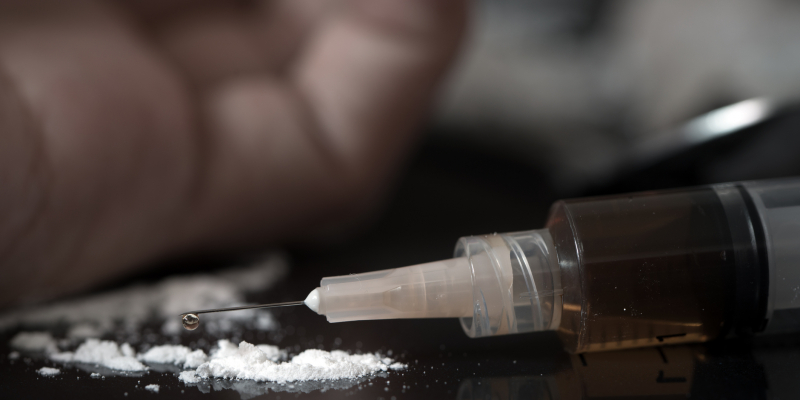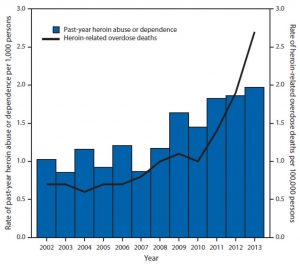
As you’re probably aware, heroin addiction in America is increasing at an extremely high rate. Let’s take a look at a graph from the CDC that showcases heroin use and abuse in Americans over time:

Yikes! From 2002 to 2013, heroin-related overdose deaths have almost quintupled! Americans are using heroin in ever increasing quantities, and it’s important to understand how and why this is happening, especially when it impacts average Americans.
What’s the problem?
The problem our country faces is both simple and complex. On one hand, it’s easy to define what’s wrong: too many Americans are addicted to heroin, and too many Americans are dying due to heroin overdoses. On the other hand, the situation is highly intricate: what’s causing this addiction? Why are people getting addicted to heroin, and even more so, why are they dying from it? While heroin has its own unique and addictive qualities, we must first consider how the human body gets addicted to drugs in the first place:
- A person uses a drug like heroin.
- This drug releases a chemical within their brain called dopamine.
- A special part of the brain called the nucleus accumbens, which is specifically responsible for responding to dopamine and creating feelings of pleasure, is forced to respond to extremely potent bursts of dopamine in quantities that are much higher than those the human body produces naturally. These bursts of dopamine create feelings of pleasure within the brain.
- The hippocampus, a part of the brain that’s responsible for memory, remembers that these bursts of dopamine cause extreme pleasure within the brain. This creates positive memories of the drug in your brain, making you feel as if using the drug was a positive experience.
- The amygdala associates the usage of the drug with pleasure in a subconscious manner. This step is similar to step 4, except its subconscious, meaning it works at a level deeper than you’re capable of controlling. Other examples of subconscious brain functions include regulating your heartbeat and breathing. The amygdala makes drug addiction particularly difficult to deal with as it causes addiction to be subconscious.
- Over time, your body builds up a tolerance to the drug and your brain stops responding to dopamine. As a drug user, you continue to use drugs, hoping to get back the same dopamine rush that you’re used to when you started using drugs, but it never comes.
So, we know that the first step of addiction is using a dopamine releasing drug. But how do people who have never tried drugs before encounter such substances? Surprisingly, at the doctor’s office.
Heroin is an opiate, or a drug made from the opium plant. Many common painkillers, including morphine, oxycodone, codeine, and hydromorphone are opioids, which are chemically synthesized drugs intended to have effects similar to those of opiates. Opiates and opioids are both similar in nature and produce similar effects within the body, but opioids are chemically synthesized, not natural. Heroin abuse often begins with an opioid painkiller prescribed by a doctor.
Many people (falsely) think that doctor prescribed drugs are always safe and can be used continually without repercussion, but they don’t realize that prescription drugs are just that — drugs! After using opioid painkillers for some time, many consumers of these drugs become addicted to them and want to continue using them after their prescriptions run out. For this reason, they turn to other drugs like heroin. Remember that by this point, many of these people have already built up a tolerance to heroin and their bodies no longer respond to the large amounts of dopamine that are released when using the drug. For this reason, these people end up consuming larger and larger amounts of heroin until they eventually overdose and die.
Complementing the addiction problem is another drug called fentanyl. Fentanyl is also an opium-based drug, except it’s many times more potent than heroin. Many drug dealers don’t realize this and they end up mixing fentanyl and heroin as if they are equal. However, most consumers don’t realize that their heroin is contaminated with fentanyl and they end up ingesting more drugs than their body can handle, which also contributes to the large amount of heroin overdose deaths in the US.
How can we help curb this issue?
There’s no doubt that heroin / opiate / opioid addiction is a very serious problem in America. More and more, we can see people close to us dying of heroin addiction. Aside from personal examples, the numbers don’t lie. Heroin addiction has nearly doubled and heroin deaths have nearly quintupled in the last 10 years!
While it’s true that opium-based painkillers such as morphine can be extremely effective, it’s also important to understand that they can also be highly addictive. For this reason, you must exercise caution while taking such medication, even if it’s prescribed by your doctor. By educating yourself on the matter and understanding the various pros and cons of each type of painkiller available today, you gain a better understanding of what medications can lead to drug addiction after several months of use. If you know that your doctor is going to prescribe you a drug like morphine or oxycodone, you should speak with them about some of the risks and reevaluate whether or not that medicine is, in fact, the right one for you.
In some cases, using opium-based medications even for legitimate purposes, is unavoidable. In situations like these, it’s important to have the support of your friends or family to watch over you while you use this medication, ensuring that you’re taking it in the proper dosages and using it in a responsible manner. Ultimately, however, nobody can exercise caution the way you can, and it’s important to know the dangers associated with opium-based medications and drugs and consider them as you explore your options.
If you know someone who is addicted to any kind of drug, it’s important to intervene early on and remind them that there is trouble involved. The first step to solving any problem is admitting it exists. Hopefully, you’re able to have a positive impact on someone’s life with the knowledge you gained from this article. Remember that it’s not wrong to seek help, and there’s no shame in reaching out to your loved ones if you’re experiencing trouble yourself.
Contact Clearbrook For Heroin Addiction Treatment Today
If you or someone you love is struggling with a heroin addiction, treatment and help are available. For more than 40 years, Clearbrook Treatment Centers has been providing effective drug and alcohol treatment to the suffering individual. Please know that there is a way out from the grips of addiction; there is hope. If you are ready to make a change and are ready to get your life back, please contact our Admissions Specialists today. They are available 24 hours a day to answer any questions you may have regarding our programs, services, and the admissions process.







